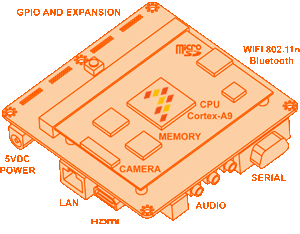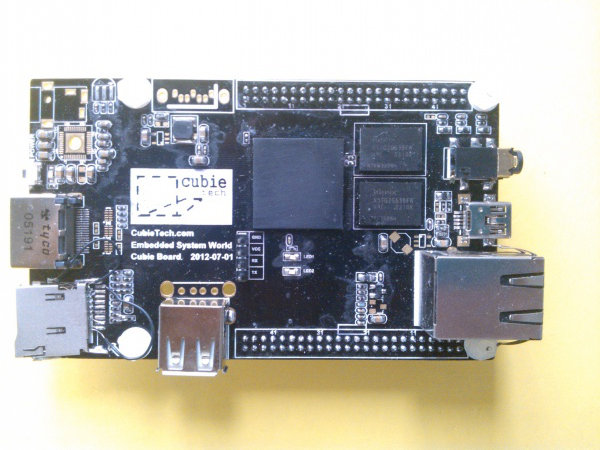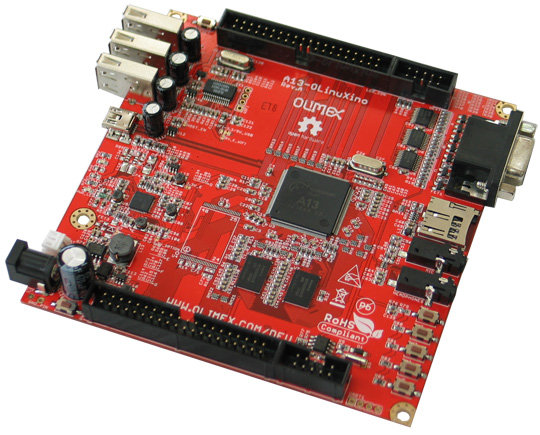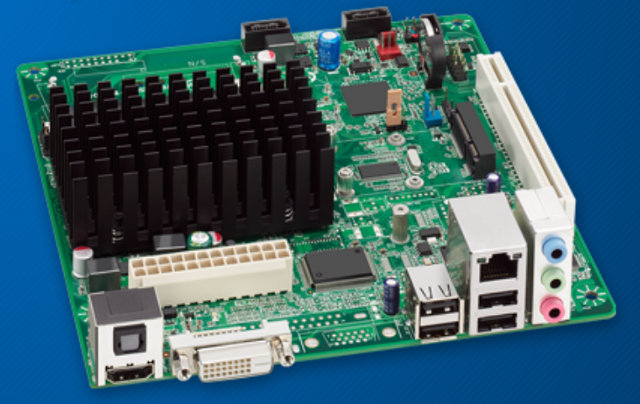Reader onebir tipped me about a low cost Intel Atom based PC on Aliexpress with some decent specs. Kingdel NC270 PC is based on Intel Atom N270 processor @ 1.6 Ghz with 2 GB RAM and 8 GB SSD. It is capable of decoding 720p HD video and features lots of ports which could make it a good entry-level digital signage player among other things. Here are the specs of this nettop. Processor – Intel Atom n270 System Memory – 2 GB (in most places, but it’s also written 1GB in one place in the description) Storage – 8GB SSD (16GB and 320GB version is also available) Connectivity: 10/100 Ethernet WiFi (optional?) Serial Ports – female DB-25, compatible SPP, ECP and EPP | male DB-9, compatible FIFO prefix = st1 16C550 2 PS/2 port (mouse, keyboard) USB – 6 USB host 2.0 ports 1x PCI slot Video Output – VGA […]
$69 – $89 Wandboard Freescale i.MX6 Solo and Dual Development Boards
The Wandboard is a low cost Linux ARM Cortex-A9 ARM board comprised of a CPU module and an interface board. There are actually 2 versions of the board (single and dual core) which are developed by a team of engineers during their spare time: Wandboard Solo – $69 – Freescale i.MX6 Solo + 512 MB RAM Wandboard Dual – $89 – Freescale i.MX6 Dual + 1 GB RAM Both boards come with Audio I/O, Optical S/PDIF, HDMI, a camera interface, 2 micro SD cardslot, a serial port, an expansion header, USB and USB OTG ports, a SATA connector and Gb Ethernet. The dual version also adds Wifi 802.11 b/g/n and Bluetooth support. There are not so many boards with native SATA support, so for those of you who need SATA this could be really be a good option. [Update: Although there’s a SATA connector on the baseboard, this is not […]
Linaro 12.09 Release with Kernel 3.6 and Android 4.1.1
Linaro release 12.09 has just been announced, and includes Linux Kernel 3.6-rc6 and Android Jelly Bean. This release provides further improvement to Android Jelly Bean, Android benchmark characterization, an ARMv8 OpenEmbedded image, UEFI bootloader support for Vexpress, origen and pandabords, and some improvement to big.LITTLE and power management. Here are the highlights of the release: Android All Linaro patches are now available on Jelly Bean. Accelerated graphics is now available on Snowball Jelly Bean build. AndEBench, AndEBench Java, Linpack, CaffeineMark, Antutu 2D and 3D, NBench, Quadrant, I/O Benchmark, Vellamo benchmark hotspot characterization available. An Origen tracking build is available and will be released this cycle as a Linaro Evaluation Build (LEB). Audio works on Origen running Jelly Bean (WAV file only). A Monkeyrunner script to run Streamline has been completed. First rev of the NI PXIe-4154 based power measurement system is created. See http://www.youtube.com/watch?v=9bKyuxLl4iw&feature=plcp In-tree AOSP tests have been automated. […]
Building Kernel Modules for AllWinner A10 Android Devices (e.g. Joystick Support)
Reader JP has enabled Joystick support in Android 4.0.4 on its Mele A1000, this now works with a Playstation2 joystick via USB adapter, a Huskee PC joystick, and 2 other unbranded joysticks. In order to enable Joystick support he had to build a kernel module, and encountered a few issues, so he wrote an how-to which shows what challenges he went through and what solutions he found to those issues.I’m sharing today a slightly edited version of this how-to. This How-to assumes that you have a valid Linux environment where you can build allwinner A10 kernel. The toolchain used was “Sourcery CodeBench for ARM GNU/Linux Lite“ which can be downloaded here: http://www.codesourcery.com/sgpp/lite/arm/portal/package7853/public/arm-none-linux-gnueabi/arm-2010.09-50-arm-none-linux-gnueabi.bin To install it, simply run:
|
1 |
sudo ./arm-2010.09-50-arm-none-linux-gnueabi.bin |
You’ll also need the latest Allwinner A10 kernel source:
|
1 |
git clone git://github.com/amery/linux-allwinner.git |
Then follow the usual procedure:
|
1 2 |
make ARCH=arm sun4i_crane_defconfig make menuconfig ARCH=arm |
I then selected the modules needed for different kind of joysticks namely:
|
1 2 3 4 5 6 7 8 9 10 11 12 13 14 15 16 17 |
--- Networking support <*> Bluetooth subsystem support ---> <M> HIDP protocol support Bluetooth device drivers ---> <M> HCI USB driver [*] HID Devices ---> Special HID drivers ---> <M> Sony PS3 controller <M> DragonRise Inc. game controller [*] DragonRise Inc. force feedback <M> Pantherlord/GreenAsia game controller [*] Pantherlord force feedback support <M> GreenAsia (Product ID 0x12) game controller support [*] GreenAsia (Product ID 0x12) force feedback support <M> SmartJoy PLUS PS2/USB adapter support [*] SmartJoy PLUS PS2/USB adapter force feedback support |
I saved the […]
$49 Cubieboard: AllWinner A10 Open Hardware Development Board
The Cubieboard is a development board for the AllWinner A10 Cortex A8 processor. Contrary to some other AllWinner A10 “development board” that are simply based on a tablet or mini PC PCB, the cubieboard has been designed specifically as a development platform and provides access to I/O pins. Here are the specs of this development board: SoC – AllWinner A10 1GHz ARM cortex-A8 processor with Mali400 GPU System RAM – 1GB DDR3 @400MHz Storage – 2 MMC slot Video Output – HDMI 1080p Connectivity – 10/100M Ethernet USB – 2 USB Host, 1 USB OTG 1 IR sensor 96 expansion pins including i2c, spi, lvds, sata… Wi-Fi and Bluetooth can be supported via external USB dongle(s). The prototype above is the first revision of the hardware, and final hardware may look different. Some connectors (e.g. SATA) are not soldered in the picture above. The cubieboard is expected to be an […]
Linaro 12.08 Release with Kernel 3.6 and Android 4.1.1 Jelly Bean
Linaro release 12.08 includes Linux Kernel 3.6-rc2 and is the very first release with Android Jelly Bean (4.1.1-R4). The Android platform team has managed to port Android Jelly Bean to all their main development platforms: Versatile Express, Versatile Express RTSM, Samsung Origen, TI PandaBoard, ST Ericsson Snowball, as well as Samsung Galaxy Nexus smartphone. They’ve also added TINY_ANDROID, a minimal Android build that can be used for kernel development, toolchain work and other development where users only need a console. It’s possible to get the source code, build it and access the shell within 10 minutes. U-boot-Linaro has been updated and is now based on the latest upstream release v2012.07. Next month, we might be able to see a preliminary port of Android on 64-bit platform (ARMv8). Here are the highlights of the release: Android Automated Methanol (http://gitorious.org/methanol) browser benchmarking in Linaro Android. Automated over 100 Jelly Bean AOSP tests. […]
Olimex A13-OLinuXino-WIFI Developer Edition is Now Available
Olimex has announced that they started shipping A13-OLinuXino-WIFI-DEV, an AllWinner A13 development board with 512 MB, 4GB and a Realtek RTL8188CU Wi-Fi module that costs 55.00 Euros with free shipping by courier for a limited time. They announced the start of this project late April, so it took them just 3 months to bring this board to to market. The board has the following specs: SoC – AllWinner A13 Cortex A8 processor at 1GHz, 3D Mali400 GPU Memory – 512 MB RAM Storage – 4GB NAND flash + SD Card slot Power – 6-16VDC input power supply, noise immune design USB – 3 + 1 USB Host, 3 available for users and 1 for Wi-Fi module + 1 USB OTG port Wi-Fi – WIFI RTL8188CU 802.11n 150Mbit module on board Video output – VGA video output + LCD signals available on connector. Audio Output / Input RTC – PCF8536 on […]
Intel to Give Away 5 Atom D2700 Development Kits to Selected Engineers
As part of its “Eureka! Design Challenges“, Intel is asking hardware engineers to submit ideas about what they’ll do with an Intel Atom D2700 development kit with 2Gb RAM, a 40 GB SSD drive & lots of ports and expansions, and will give one to the 5 candidates with the best project ideas. Here are the key features of this development kit: Development board with the Intel Atom Processor D2700, and IntelNM10 Express Chipset Board Support package from the Linux Foundation’s Yocto Project 2GB DDR21066 MT/s non-ECC memory 40GB SSD, installed, with SATA extension cable Power supply The Intel Software Development Tool Suite (GNU tool compatible) Documentation and software Comes in a mini-ITX chassis with dual independent display capabilities. I’m not sure why Intel is focusing on hardware engineer for this type of project, and I suppose if you have some embedded systems development ideas that interface with external hardware, […]








